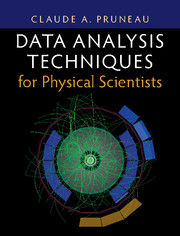Book contents
- Frontmatter
- Dedication
- Contents
- Preface
- How to Read This Book
- 1 The Scientific Method
- Part I Foundation in Probability and Statistics
- Part II Measurement Techniques
- 8 Basic Measurements
- 9 Event Reconstruction
- 10 Correlation Functions
- 11 The Multiple Facets of Correlation Functions
- 12 Data Correction Methods
- Part III Simulation Techniques
- References
- Index
12 - Data Correction Methods
from Part II - Measurement Techniques
Published online by Cambridge University Press: 24 October 2017
- Frontmatter
- Dedication
- Contents
- Preface
- How to Read This Book
- 1 The Scientific Method
- Part I Foundation in Probability and Statistics
- Part II Measurement Techniques
- 8 Basic Measurements
- 9 Event Reconstruction
- 10 Correlation Functions
- 11 The Multiple Facets of Correlation Functions
- 12 Data Correction Methods
- Part III Simulation Techniques
- References
- Index
Summary
No measurement is ever perfect. Measurement errors and uncertainties are indeed an intrinsic part of the scientific process. Skilled scientists, however, can devise techniques to minimize errors and correct for biases. In this chapter, we discuss the notions of accuracy, precision, and biases, and examine various sources and types of errors in § 12.1. We then present, in § 12.2, a discussion of specific sources of uncertainties arising in the nuclear sciences. Techniques to unfold detection efficiencies and resolution effects in the measurement of spectra and elementary cross sections are presented in § 12.3 while correction techniques relevant for correlation and fluctuation observables are discussed in § 12.4.
Experimental Errors
An experimental error may be defined as the difference between a measured (observed) value and the true value. This of course assumes the observable of interest is meaningfully defined and in fact has a true value. It should be clear, however, that there can be difficulties with this idea. Certain physical quantities such as temperature are defined only in the context of a large number limit. Indeed, while it is meaningful to speak of the temperature of gas consisting of a very large number of molecules, the notion of temperature becomes meaningless in the presence of only one or two particles. Limitations may also arise because of the quantum nature of phenomena. For instance, there is an intrinsic limitation in simultaneously measuring the instantaneous position and momentum of an elementary particle, although it is perfectly sensible to consider the expectation values (i.e., average) of these two observables.
The true value of a physics observable is, of course, unknown a priori otherwise there would be no reason to conduct an experiment. Knowing the error of a measurement is obviously also impossible, and one must then use the language of probability and statistics to estimate both the true value and the error. Properly conducted measurements, with a sound statistical analysis, are thus expected to yield values close to the true value but without guarantee of ever reaching it with infinite precision or accuracy.
- Type
- Chapter
- Information
- Data Analysis Techniques for Physical Scientists , pp. 577 - 640Publisher: Cambridge University PressPrint publication year: 2017



